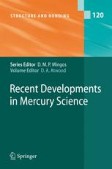Search
Search Results
-
Preparation of bulk micro–mesoporous silica-supported ZnO via silicic acid as a desulfurizer
Silicic acid solution, which is prepared from water glass followed by extraction with tetrahydrofuran (THF), is focused on an environmentally...

-
Carbene Complexes of Heme Proteins and Iron Porphyrin Models
The possible formation of carbene complexes of cytochromes P450 enzymes in various metabolisms of xenobiotics is first described. In view of these...
-
Ferrocene–Peptide Bioconjugates
This chapter sketches an outline of ferrocene–peptide bioconjugates. A variety of ferrocene–peptide bioconjugates have been designed to induce...
-
Catalytic Nickel–Iron–Sulfur Clusters: From Minerals to Enzymes
The geochemical theory of the origin of life proposes that primordial, pre-biotic reactions were carried out in a metal-sulfide-rich environment...
-
Sequentially Palladium-Catalyzed Processes
Sequentially palladium-catalyzed reactions consist of combinations of identical, related, or significantly different palladium-catalyzed processes...
-
Structural Aspects of Layered Double Hydroxides
Layered double hydroxides (LDHs) have been known for a considerable time and have been widely studied. The basic features of their structure,...
-
n-Body Decomposition Approach to the Calculation of Interaction Energies of Water Clusters
A new methodology is proposed in which large basis set MP2-level calculations can be extended to water clusters with as many as 50 monomers. The...
-
Multiporphyrin ArraysAssembled Through Hydrogen Bonding
Although relatively weak in isolation, composite H-bonds can be used as an advantage for the assembly of relatively robust and well-defined arrays...
-
Axial Coordination to Metalloporphyrins Leading to Multinuclear Assemblies
The use of axial coordination to metalloporphyrins is discussed on the basis of constructing multinuclear complexes. Starting with single...
-
Poly(mercaptoimidazolyl)borate Complexes of Cadmium and Mercury
The coordination chemistry of bis- and tris(mercaptoimidazolyl)borate ligands with both main-group and transition metals is rapidly expanding....
-
Mercury Removal from Water
Mercury pollution in water is a serious threat to natural ecosystems. Various methods and technologies are in use to remove mercury from the...
-
Intermolecular Interactions via Perturbation Theory: From Diatoms to Biomolecules
This article is devoted to the most recent, i.e. taking place within the last few years, theoretical developments in the field of intermolecular...
-
Ce-Ni (Cerium - Nickel)
This document is part of Subvolume B5 'Binary Systems. Part 5: Binary Systems Supplement 1' of Volume 19 'Thermodynamic Properties of Inorganic...
-
Ag-Cr (Silver - Chromium)
This document is part of Subvolume B5 'Binary Systems. Part 5: Binary Systems Supplement 1' of Volume 19 'Thermodynamic Properties of Inorganic...
-
Ag-Fe (Silver - Iron)
This document is part of Subvolume B5 'Binary Systems. Part 5: Binary Systems Supplement 1' of Volume 19 'Thermodynamic Properties of Inorganic...
-
Ag-Cu (Silver - Copper)
This document is part of Subvolume B5 'Binary Systems. Part 5: Binary Systems Supplement 1' of Volume 19 'Thermodynamic Properties of Inorganic...
-
Mn-Sc (Manganese - Scandium)
This document is part of Subvolume B5 'Binary Systems. Part 5: Binary Systems Supplement 1' of Volume 19 'Thermodynamic Properties of Inorganic...
-
Hg-Zn (Mercury - Zinc)
This document is part of Subvolume B5 'Binary Systems. Part 5: Binary Systems Supplement 1' of Volume 19 'Thermodynamic Properties of Inorganic...
-
Os-Si (Osmium - Silicon)
This document is part of Subvolume B5 'Binary Systems. Part 5: Binary Systems Supplement 1' of Volume 19 'Thermodynamic Properties of Inorganic...
-
Cu-Ir (Copper - Iridium)
This document is part of Subvolume B5 'Binary Systems. Part 5: Binary Systems Supplement 1' of Volume 19 'Thermodynamic Properties of Inorganic...
